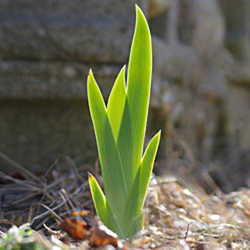(Editor's Note: This article was originally published on March 6, 2008. Your comments are welcome, but please be aware that authors of previously published articles may not be able to respond to your questions.)
Early spring is the time for three important tasks in the iris garden: cleanup, fertilizing, and borer control. Clear away any winter mulch, old leaves, and miscellaneous debris from your bearded irises. Test the soil, and apply a granular fertilizer for better blooms and more vigorous growth.
Take steps to control the dreaded iris borer (Macronoctua onusta), if present in your area, at its most vulnerable time of the year.


Cleanup: when, what, and why?
If you've put Christmas tree branches, straw, or anything else on your bearded irises to prevent heaving during freeze-thaw cycles, clear it away. Any kind of mulch around the rhizomes during spring rains may lead to rot. Floppy leaves and debris can also harbor leaf-munching slugs. Some gardeners trim their iris foliage after the first hard fall freeze. Others leave old green leaves in place to provide a little winter protection and continue feeding the rhizome on mild days. Cleanup is also important for borer control. Iris borers are present in many but not all states in the US, especially in the Northeast, MidAtlantic, and Midwest regions. Check with your agricultural extension service or your local chapter of the American Iris Society to see if they are in your area.
When temperatures warm to 70°F in spring, borer eggs hatch. Larvae burrow into the leaves. In midsummer, they migrate down to the rhizome. That's when the real trouble begins. Tiny borer larvae become fat grubs that can badly damage entire stands of irises before pupating and emerging as egg-laying moths in fall. Never compost iris leaves. Throw them away as you would any potentially diseased plant material.
Some suggest removing only dead or dying foliage to eliminate most of the iris borer eggs that may be present. DG's Laurief takes a more ruthless approach to eliminating borers from her irises. Her advice: "When gardening within the borer's range (regardless of whether or not borers have been identified in your particular garden), any foliage which was not removed in fall should be removed all the way down to the rhizome before active growth begins in the spring." [1]
As you clean up around your bearded irises, you may notice that some of the rhizomes have heaved right up out of the ground during winter freeze-thaw cycles. There's no need for alarm. Give the rhizome a squeeze to see if it still feels firm and healthy, then just shove it back into place.Occasionally, you may find a rhizome that has developed smelly soft rot over the winter. If some part of the rhizome remains firm, you can try to salvage it. Either cut off the soft portion, dip the rhizome in a bleach solution, and replant it. [2] Or, treat it in place by scraping off all soft areas until only potato-like firm rhizome remains, then sprinkle copper or antibacterial powder or a cleanser such as Ajax on exposed surfaces. Widespread rot can be an indication of borer damage. 

To fertilize, or not to fertilize?
Many gardeners fertilize their bearded irises in early spring for a fabulous show of summer blooms, using a "bloom booster" product with a high middle number in its N-P-K ratio. However, the only thing irises may resent more than underfeeding is overfeeding. "First, do no harm!" Before applying any fertilizer to your garden, do a soil test to discover what your plants actually need. [3] Your soil test may also reveal a need to correct pH or add trace minerals, so you'll be checking for more than just the need to boost phosphate levels. If you do decide your irises need to be fertilized, granular fertilizers should be applied about six weeks before bloom time.
What else can I do to control borers?
If you live in an area where iris borers are a problem, you may wish to practice prevention beyond spring cleanup. Just as irises are breaking winter dormancy, you could apply a granular grub control product containing imidacloprid , also known as Merit. This same systemic insecticide is used in Advantage flea and tick control products. Bayer Advanced Lawn Season-Long Grub Control, and Scotts Grub-X are brands containing imidacloprid. Check the labels to make sure the product contains at least 0.2% imidacloprid.
 It's important to get the product down before warm weather arrives, as imidacloprid is only effective against newly hatched borers. The granular form can be applied directly around each clump (1/2 to 1 teaspoon per clump) and watered in. Imidacloprid is also available as a wettable powder for spray application. Use one form or the other, not both, as double dosing could damage your plants. Follow directions and precautions on the product label.
It's important to get the product down before warm weather arrives, as imidacloprid is only effective against newly hatched borers. The granular form can be applied directly around each clump (1/2 to 1 teaspoon per clump) and watered in. Imidacloprid is also available as a wettable powder for spray application. Use one form or the other, not both, as double dosing could damage your plants. Follow directions and precautions on the product label.
Broad spectrum pesticides may be useful to kill borers present in iris foliage in early to mid summer. DG's avmoran uses Spectracide Triacizide 6 weeks after applying imidacloprid to her irises. She says it also helps against wireworms, Japanese beetles, and other pests. [4]
Organic alternatives may also be effective and are becoming more important as concerns are raised about potential groundwater contamination and about the possible effects of pesticides on dwindling honeybee populations. [5] There have been promising studies of treatment with beneficial nematodes. [6] Iris borer larvae can even be eliminated effectively, if tediously, from the foliage during the summer months. Flattening each leaf carefully between your fingers should squash any borer larvae within.
 Is it time for summer blooms yet?
Is it time for summer blooms yet?
It's more fun to work among your bearded irises when they're blooming madly. But the time you spend now cleaning up, fertilizing, and taking steps to prevent and control iris borers will pay off tenfold in just a few weeks. Be sure to stop by the DG Iris Forum, and post photos of your garden in bloom!
Photo credits: Thanks to DGer TBGDN for the clear images of iris borers and the damage they do. See the notes on iris borers in his garden journal for more information. Thanks also to JanieJoy for the photo of a borer on a freshly dug iris rhizome. The photos of irises in my garden were taken by me.
[1] Personal communication. Laurie is an avid iris gardener with over 12 years of experience growing both bearded and beardless irises in the challenging climate of northern Minnesota. More great tips and information can be found on her Shadowood Iris Garden FAQ page.
[2] See my 2007 DG article "Planting Iris 101" for bleaching and planting tips.
[3] Contact your local agricultural extension service about free or low cost soil testing services. Read more in this DG article, "Don't Guess, Soil Test"
[4] Personal communication. Anita is an active member of my local AIS chapter and a frequent contributor to discussions on the DG iris forum. For a treat, check out her gallery of iris photos and descriptions at Pilmore Iris Garden.
[5] As with any pesticide, there are pros and cons to the use of imidacloprid. For more information about imidacloprid and bees, see this article on the Canadian Honey Council site, and see this response from Bayer. The Journal of Pesticide Reform published these concerns in 2001. For more information about New York's restrictions on imidacloprid due to groundwater concerns, see these links: Imidacloprid Status in NYS 10/03 and Imidacloprid BMP Greenhouses and Nurseries.
[6] For further discussion of treatment with beneficial nematodes as well as additional information about iris borers, see this Iris Borer Information page from the Canadian Iris Society and this University of Minnesota Extension Service Yard & Garden Brief: Iris Borers.

















